Not being able to get down from a chair is a typical toddler problem. They can't handle what they get themselves into. And overreacting and saying, "Why did you climb up there in the first place?" is a typical parent problem. Toddlers can't get down because they haven't learned that skill - yet. But they will, and you can help by showing them how. Children this age can usually get down from a table or chair that is waist-high. Higher than that gets a little dicey.
Puzzles.
Even the simplest puzzles may be too hard for your child to do alone at this age. Give help freely, and be patient. When your child is two, he or she
will be more successful.
Sorting things is a common household task that your child can "help" you with, if you are willing. For example, children with clean hands can help you put the silverware away. Or they can help you put the lids to pots and pans away. Sorting toys in a messy room is a headache. With your child's help it can turn into a learning activity - if you're in the right mood and if you have the time. If you don't have the right mood and enough time, don't try it. You may prefer to sort silverware or pick up your child's room quietly all by yourself after your child goes to bed.
Provide your child with fat crayons and paper to draw on. Observe what happens. When children first start to color, they usually make light strokes on paper. They grasp the crayon in their fist because they can't yet grasp it the way you do. Later, they'll be able to hold it in the more conventional way. Children are amazed by the simple lines they draw.
Sometimes paper slips around too much for children to draw upon it. You can solve this problem by using masking tape to hold the paper down. If you like, put on some music and draw with your child. Children often like to share a drawing with you. You make a few lines on paper, then your child makes a few more lines, and so on.
When your child is finished coloring, he or she should put the crayons away. Demonstrate this process enthusiastically, making the task seem like an interesting challenge. You may want to put the crayons away on a high shelf so that they can only be taken out by a grown-up.
Your child's first drawings may not look so great to the rest of the world, but to you and your child, they are spectacular. Refrigerators make perfect galleries for children's art. Use nonstick masking tape or big magnets, and post the drawings where you and your child can peruse them. Talk about them together. You may soon have more drawings than your refrigerator can hold. Other uses? Wrapping paper, stationery for grandparents, framed pictures for presents for grandparents and friends.
Young children like to play with other children, especially familiar children. They are fascinated by them. Sometimes all they do is stare at one another. Toddlers sometimes may not look like they are playing, but they are enjoying themselves. They also like to investigate one another's toys.
Sometimes the most successful pairings are of children of slightly different ages. The younger child enjoys observing the older one, and the older one enjoys being the more capable one.
... And Enemies
Young children can get mad, jealous, embarrassed, hurt, and just plain nasty. Sometimes they fight because their angry feelings overwhelm them. Sometimes they fight just for the experience of it. They've seen other kids hit each other, and they want to try that behavior themselves. And sometimes they fight because they are tired. The first thing to do when children fight is to separate them. Say, "No fighting," and offer an alternative: a snack, a different toy for each, a story, or possibly even a nap.
Food Play - Bad
The enduring conundrum for parents of toddlers is how to set limits for those children who freely act out their ideas and emotions. Take mealtime. Feeding a toddler can go smoothly one day and be a nightmare the next. A child who knows how to eat now makes a complete mess of things, laughing and spitting and refusing to eat and even throwing food on the floor. What do you do when you are faced with a toddler who is losing it? Number one: Don't laugh. Number two: Take the food away, explaining simply that "food is not for playing; food is for eating." Don't overreact. Both yelling and spanking scare and hurt toddlers.
Food Play - Good
Because children do like to touch food and prepare things with it, they enjoy "cooking" on their level. Toddlers can make these recipes, if you help them.
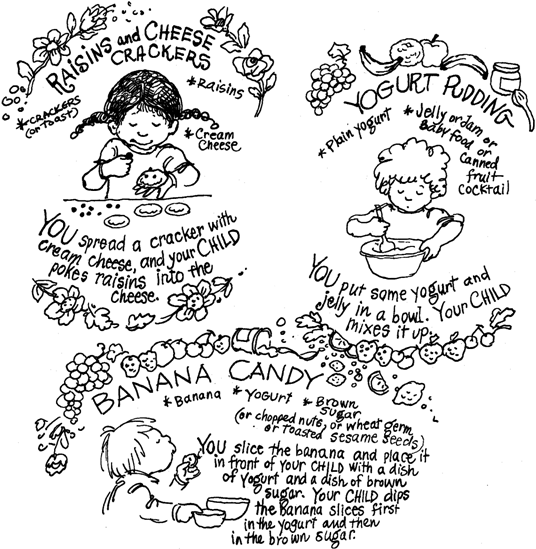
"Whazzat?"
At some point your toddler makes the brilliant discovery that absolutely everything has a name. And being a curious soul, your toddler now decides to learn all these names, or at least to ask about them. Not every name will be remembered, but your toddler loves to point at things and ask, "Whazzat?" 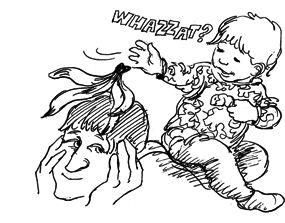
Answer, of course, briefly. You don't need to go into long explanations.
A simple name will do. If you get the feeling, as you undoubtedly will at times, that your child is less interested in learning a name and more interested in getting you to respond, you might consider giving your child what he or she really needs, which probably is a little more attention.
If your child is tormenting you with Whazzats, try distracting him or her with another activity.
The Toddler Interrogator
The same goes for the other favorite question that toddlers like to ask, "Why?" Does your child really want a full explanation of a particular phenomenon or parental directive, or is your child just saying a new and exciting word to get a response from you?
Because I said so.
"Because I said so" is a parent's last response to children demanding to know why they have to put on a hat, take a bath, or go to bed. After you have given the honest reason clearly several times (because it's cold, because you're dirty, because people need to sleep), you may find yourself saying what you hated to hear your parents say, "Because
I said so." When you think about it, it's not a bad answer, but your child has you beat anyway by now saying, "Why?" In other words, why did you say so? Don't bother to explain. Give up, smile, hug your child, and start the water for the bath. In general, answer toddlers' questions about everyday events as simply as possible. Long-winded explanations go over their heads. Children will continue to ask why as they grow. When they are older, they will understand explanations better.
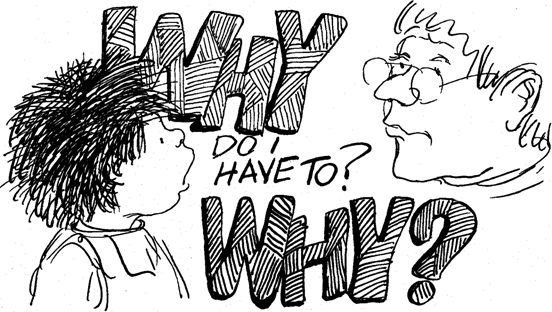
Saying Short Sentences
Many toddlers this age use three- or four-word sentences. They seem to grasp the idea of subject and verb. Exactly how this happens, no one knows; but all experts say that children need to hear language in order to learn how to use it. The more children hear, the more they begin to understand how language works. If you keep a tape recorder or video camera handy, you can record your child's words and sentences. If you record your child every month or so, you'll have a wonderful record of how your child learned to talk. If you do make a tape or video of your child's developing language skills, consider sending a copy of it to grandparents and other relatives far away.
Listen to Your Child
Communication is a two-way street; it involves talking and listening. Don't tune out your child. Whether your child is an early talker, a late talker, or somewhere in the middle, pay attention and show that you care. If you want your child to listen to you, you have to listen to your child.
My Vocabulary Grows
Your toddler may be able to say as many as twenty words now. The words may not be pronounced correctly, but they are real words that stand for people and things your child knows. Not all children say what they know out loud. A certain few seem to wait until they can speak well before they say a word. If you are worried about your child's progress, consult your pediatrician. Otherwise, enjoy your child's vocabulary, and, if you like, keep a pad handy to list the words your child is learning. In the coming months the list will grow longer and longer.
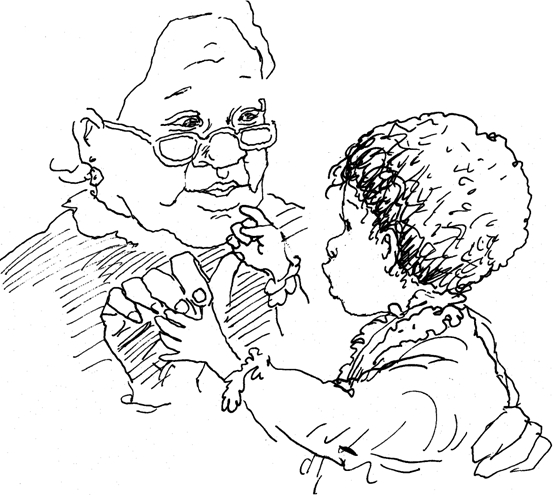
20 Words
Make sure your child is immersed in a language-rich environment. You don't want your child to be bombarded with boring words all day long, but you do want your child to perceive the pleasures and intimacy of language. When you chat and play with your child, you provide exactly the right kind of language stimulation. TV, on the other hand, does not do the trick. It's too impersonal. Toddlers need you and other caring people to talk with them.
Toddlers love chants.
You can make up chants about anything. Just say the same sentence over and over with slight variations each time. Clap or bounce your child on your lap as you chant. Eventually your child will be able to chant with you.

Feelings ...
Learning how you feel about something is important to young children, who experience a full range of emotions before they are able to identify them. Learning that others, especially you, share the same kinds of comfortable and not-so-comfortable feelings is helpful. Your child copies you. If your child hears you talk about your feelings and watches you handle your feelings without hurting others, your child will learn that a variety of feelings are normal and that there are interesting words for describing them. Your child will learn that talking about feelings can help to alleviate them.
Kicking, biting, hair pulling, and punching:
Help your child understand that it's okay to feel angry, but that it's not okay to hurt others. Don't make the mistake of condoning harmful activities just because you understand your child's feelings. Hurtful behaviors are not allowed. Offer harmless alternatives, such as punching a pillow.
... And Words for Them
Don't forget to share your feelings of love and contentment as well as your feelings of frustration and anger. Sometimes fathers who love their children very much forget to convey their love to their children.
Hassles and Mess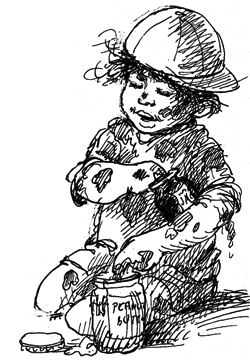
For some reason, some toddlers are fascinated with messes. They don't mind getting their hands all sticky and gooey. And they don't mind putting their sticky, gooey hands on the walls and on you. Because you often have to wipe their hands and faces, it's good to be prepared to do so, and not to be lacking a handkerchief or wipes just when you need them most.
Be prepared:
When you are out with your toddler for the afternoon, have what you need. You never know what's going to happen, and, as they say, it's better to be safe than sorry.
What to pack for toddler outings:
Clothing Diaper(s)
Wipes
Snack
Drink
Toy
Book
A Hassle-Free Glue Project
Toddlers can do this gluing project quite neatly. Perhaps the reason they like it so much is that they get to use something sticky in a proper way.
Materials needed:
• White glue, such as Elmer's
• A little dish to put the glue in
• Paper plates, cardboard, or big junk-mail envelopes
• Little things, such as pine cones and little Styrofoam packing material peanuts. Start collecting these things now for future projects.
• Newspapers (optional)
Directions:
1. Tape newspaper to the table to protect the surface, if necessary.
2. Set out two paper plates (one for your child and one for you), a little dish with a little glue in it, and a pile of little things.
3. Demonstrate how to pick up a little thing, dip it gently in a little glue, and stick it to the paper plate. Your child will copy you and feel quite proud. The finished "sculpture" can be a present for someone. Your child may be happy to do your plate for you, if you stay close by.
The Value of Water Play
Water play is both fun and educational. When children play with water and water toys, they not only enjoy themselves, but they also learn about the physical qualities of water and concepts such as full and empty, floating and sinking, heavy and light, wet and dry. These concepts are strengthened in children if you provide interesting water toys and talk about them playfully.
Water play also vents feelings. Children can slap water, squish it, pour it quickly, and act out stories with it. Try putting your child with figure toys in the bath after watching TV cartoons. What the children have repressed may come out. Water play is also an excellent way to get clean.
Warning: Water play can be dangerous. Toddlers have drowned in inches of water. Supervise them closely. Also, watch that little toys don't go down the bathtub drain.
Educational Water Play Toys
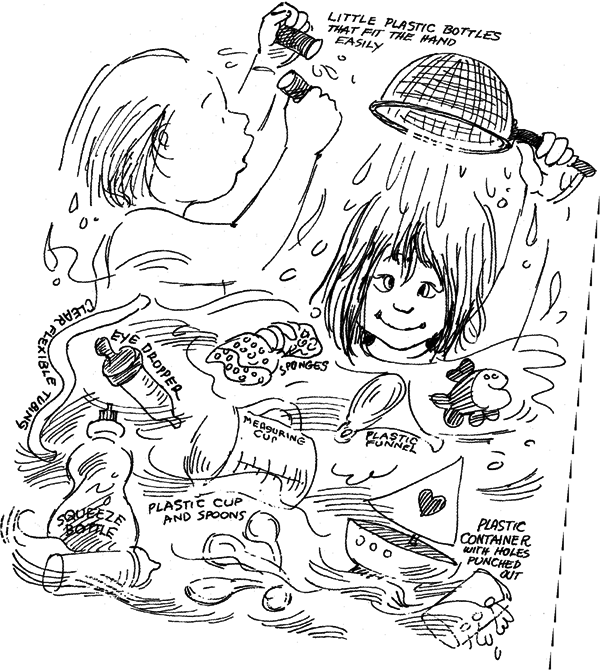
What Kinds of Toys ...
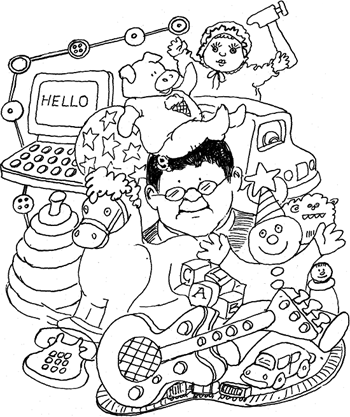
... Are Best for My Child?
A toddler toy checklist:
The best toys for your child are those that meet the following criteria:
• They are developmentally appropriate for your child.
• They are too large to be swallowed.
• They have no detachable parts that can be swallowed.
• They have no little parts that can break off and be swallowed.
• They have no sharp edges or points.
• They are well made.
• They are not made of glass or brittle plastic.
• They are nontoxic.
• They have no parts that can pinch fingers or catch hair.
• They have no long cords that could accidentally strangle a young child.
If a toy does not meet the above criteria, it should be used by the child only under very close supervision.
Toys for one-and-a-half-year-olds:
Snap-lock beads & big wooden beads
Little figures & animals
Shape toys
Teddy bear
Big, simple dump truck
Small alphabet or number blocks
Push & pull toys
Toys for two-year-olds:
Safe riding toy
Cobbler's bench
House & barn for figures & animals
Paper & fat crayons
Doll
Small cars & trucks
Single shape puzzles
Toys for two-and-a-half-year-olds:
Big wooden blocks
Tea set
Punching toy
Easy puzzles
Small nonelectric toy train
Toys for three-year-olds:
Construction trucks
Toy wheelbarrow
Tricycle
Puppets
Toy tool bench
Simple lotto games
Instant Games
Here are two games you can play with toddlers anywhere, anytime, no equipment needed, just a little space.
Follow the leader.
Have the kids make a parade with you as the leader. Ask them to do what you do and go where you go. As you parade around, say where you are going, as in, "Okay, here we go by the refrigerator, everyone touch the refrigerator, and now we're going under the table, everyone down on your hands and knees!"
Ring around the Rosie.
Have the children stand in a circle and hold hands. Walk in a circle as you sing, "Ring around the Rosie, Pockets full of posies, Ashes, ashes, All fall down!" The anticipation of and then the actual falling down is the best part for toddlers.
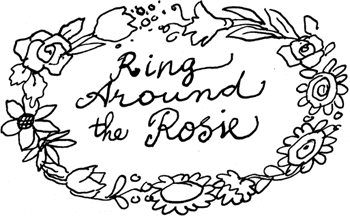
Instant Toys
Be on the alert for household objects that can be turned into instant toys. For example, an empty Band-Aid box with a little toy inside makes an instant shaker. Your child can change the contents to produce different sounds. Watch, though, that your child doesn't put little things in his or her mouth.
Other toys that can be made from common household objects:
• Cardboard toilet paper rolls can become telephones
• Cardboard paper towel rolls can become horns
• Milk cartons can be washed, dried, taped shut, and used for blocks
• Pot lids can become cymbals
• Small plastic detergent bottles with handles can be washed out and used for pouring water in the bathtub and toddler pool
• Old-fashioned, wooden peg clothespins can be little dolls, especially if you add facial features with a marker
Puppets
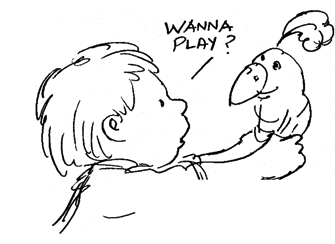 Puppets provide an opportunity for dramatic play and affection. Big but light fuzzy puppets are like dolls and teddy bears; and the nice thing about them is that you can put your hand inside and make the puppet talk to your child. This is fascinating for children. Sometimes they want to try, too, to make the puppet talk to them and to you.
Puppets provide an opportunity for dramatic play and affection. Big but light fuzzy puppets are like dolls and teddy bears; and the nice thing about them is that you can put your hand inside and make the puppet talk to your child. This is fascinating for children. Sometimes they want to try, too, to make the puppet talk to them and to you.
If you don't have a puppet, you can take an old white sock and draw a face on it with a marker. Don't worry if your artistic efforts are not earthshaking; they will be to your child because you have just made a sock come alive!
Children like stories about themselves, so if you're trying to think up a story for the puppet to tell, make your child the main character and include familiar people and happenings from your child's life.
Pets
Pets provide children with a variety of learning experiences plus the joy of possession and, depending on the pet, relationship. However, your toddler won't be able to help much in the care of a pet until he or she is older. For now, children can learn from pets that pets are not toys and that animals have certain needs, such as food, sleep, cleanliness, and exercise. When pets give birth, they provide a natural course in sex education. If you want to get a pet, select one that will adapt to your family and home.
 Dogs: Certain dogs tolerate toddlers beautifully. Find out which ones these are by consulting pet store operators, veterinarians, and other pet owners.
Dogs: Certain dogs tolerate toddlers beautifully. Find out which ones these are by consulting pet store operators, veterinarians, and other pet owners.
Cats: Cats that don't scratch and don't mind toddlers are the best. Get advice.
Guppies, turtles, and tropical fish: Children like to watch them, but make sure your child can't reach in.
Parakeets: With patience many of them can be taught to talk. Perhaps you and your child can do this together. The cage should be too high for your toddler to reach.
Gerbils: Toddlers can watch but not touch yet. Make sure they can't get into the cage.
Making Scrapbooks Together & Reading Scrapbooks as Books
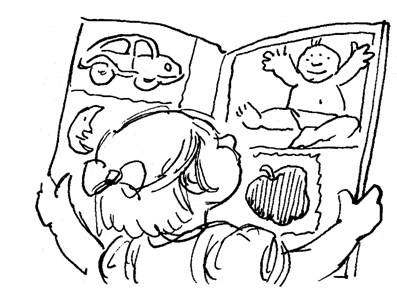 If you like to take pictures of your child, you might also like to make scrapbooks or photo albums. Instead of storing these albums away on a shelf for relatives and friends to see, why not take them down and "read" them to your toddler?
If you like to take pictures of your child, you might also like to make scrapbooks or photo albums. Instead of storing these albums away on a shelf for relatives and friends to see, why not take them down and "read" them to your toddler?
Include photos of your child's favorite people, pets, and objects. If you like, you can label the photos with words, but don't expect your toddler to read them. Still, it's okay for the words to be there for you to read ... and for your child someday to read.
Sturdy albums with plastic-coated pages will best survive the use of a toddler. If you worry that your child will wreck the photos, have double prints made, and keep one set for posterity.
Toddlers Love Books!
Bookstores and libraries have sections that feature books for toddlers. Many of the books are printed on nearly indestructible materials so that toddlers can handle them freely without inadvertently ripping them. It's nice for kids to have these books around and to have access to them, like toys.
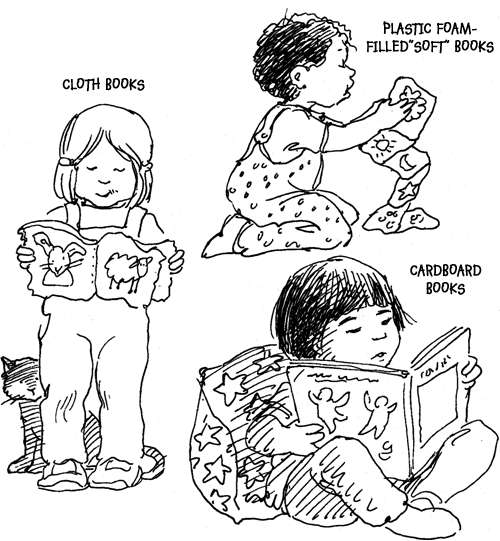
Books & Bedtime Routines
Toddlers thrive on routine. They like to sense the pattern of their day so that they can feel secure within the structure and can anticipate what's coming next. Because children love books as well as routine, a pattern that works well for many children and their families is to have a bath, a story or two, and then good night. At bath time you can discuss what books you'll read together.
CLICK FOR CHAPTER THREE

